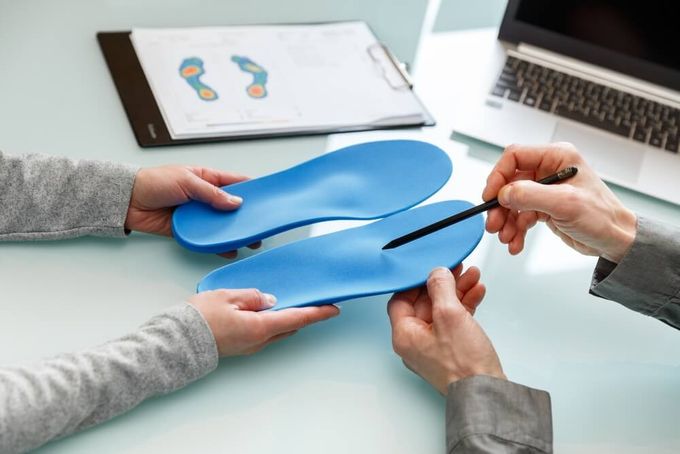The Role of Insoles in Correcting Gait Imbalances
Uncover the benefits of insoles for correcting gait abnormalities and improving quality of life with our detailed exploration.
Published March 14, 2024

Most people walk for the majority of their day, but sometimes, our feet don't move in the right way. The repetitive nature of walking can cause minor imbalances in our gait and quickly lead to injuries or other foot-related issues. If left untreated, it can eventually impact our overall quality of life and hinder our performance in daily activities.
This is where insoles play a crucial role. By providing stability and support to the feet, they help correct gait abnormalities, alleviate discomfort, and promote proper foot alignment.
What are Gait Abnormalities?
Gait imbalances are anything that doesn't align with normal walking patterns. That can be something as simple as a limp, which is probably the most common thing people think of.
It can also be taking shorter steps with one foot than the other, not striking your heel as you should and instead hitting more with your forefoot or overpronating. This behavior is referred to as rolling your foot in.
Common Types of Gait Abnormalities
Over time, gait imbalances can cause foot conditions such as:
- Flat feet
- Plantar fasciitis
- Leg length discrepancy
- Achilles tendinopathy
- Knee pain
- Morton's neuroma
» Check out these simple exercises for overpronated feet
How Insoles Work to Correct Gait Imbalances
The most common gait abnormality is overpronation, also known as flat fleet. Insoles can provide rigid arch support and help correct that imbalance, preventing your arch from collapsing into the ground when walking and correcting your gait alignment. Addressing weakness in certain foot muscles alongside orthotics may alleviate heel, ankle, foot, knee, hip, back, and neck pain for patients with these conditions.
Some insoles differ in their design or construction to target specific gait abnormalities or accommodate individual foot anatomy and biomechanics. For example, orthotics for leg length discrepancies often include heel lifts to improve walking patterns. Additionally, rigid orthotics are recommended for stability or laxity issues, and cushioning orthotics for conditions like diabetic ulcers.
Here's how you can enhance the benefits of wearing insoles:
- Gradually increase the use of orthotics to allow your body to adjust rather than transitioning suddenly.
- Use orthotics consistently in all shoes throughout the week to ensure benefits.
- Check in with the orthotic provider or therapist to ensure proper wear and address any changes in deficits.
- Pay attention to how your walking or gait feels when using the insole; consult with someone who can analyze gait for adjustments if it doesn't change as expected.
- Choose shoes with a structure like sneakers to properly contain and align the foot with the orthotic during dynamic walking motion.
- Avoid wearing insoles with loose-fitting/poorly fitted shoes.
» Explore the best insoles for overpronation
Over-the-Counter vs. Custom Insoles
A physical therapist or podiatrist is your best option for analyzing gait and working with orthotics. If they notice something abnormal, such as your foot rolling in too much, you may need arch support or some other type of orthotic.
Over-the-Counter Insoles
Over-the-counter insoles tend to be cheaper but are made for various conditions, requiring cutting to fit. However, they may not always fit properly, especially for those with wide feet. These options are suitable for general pain or additional support during activities like running.
Custom Insoles
On the other hand, custom orthotics are sized to fit the foot precisely, even though they are a bit more expensive. Research shows insoles are crucial for conditions like leg length discrepancies, rheumatoid arthritis, diabetes, and metatarsal strains.
There are a few different ways to get a specialized orthotic. One standard method is using a soft foam that a patient can step on to show the shape of their foot, including the arch and any overpronation or oversupination. This helps customize the orthotic to the person's needs, determining where it needs to be more rigid, flexible, or provide extra support.
» Uncover what conditions custom orthotics are prescribed for
Your Path to Pain-Free Movement
Whether it's a simple insole or a specialized one, addressing the issue sooner rather than later can prevent prolonged pain and speed up recovery. Correct foot alignment can also improve balance reactions, reducing the risk of falls. Further training, such as proprioception and balance exercises, can enhance stability and improve foot function.
For tailored solutions, Upstep's customized insoles ensure a proper fit by taking an imprint of the foot. Unlike generic over-the-counter options, they are tailored specifically to each person's foot shape and support requirements, optimizing comfort and effectiveness.










